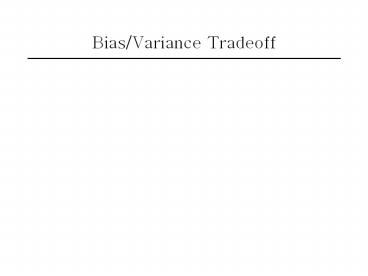Bias/Variance Tradeoff - PowerPoint PPT Presentation
Title:
Bias/Variance Tradeoff
Description:
BiasVariance Tradeoff – PowerPoint PPT presentation
Number of Views:606
Avg rating:3.0/5.0
Title: Bias/Variance Tradeoff
1
Bias/Variance Tradeoff
2
Model Loss (Error)
- Squared loss of model on test case i
- Expected prediction error
3
Bias/Variance Decomposition
4
Bias2
- Low bias
- linear regression applied to linear data
- 2nd degree polynomial applied to quadratic data
- ANN with many hidden units trained to completion
- High bias
- constant function
- linear regression applied to non-linear data
- ANN with few hidden units applied to non-linear
data
5
Variance
- Low variance
- constant function
- model independent of training data
- model depends on stable measures of data
- mean
- median
- High variance
- high degree polynomial
- ANN with many hidden units trained to completion
6
Sources of Variance in Supervised Learning
- noise in targets or input attributes
- bias (model mismatch)
- training sample
- randomness in learning algorithm
- neural net weight initialization
- randomized subsetting of train set
- cross validation, train and early stopping set
7
Bias/Variance Tradeoff
- (bias2variance) is what counts for prediction
- Often
- low bias gt high variance
- low variance gt high bias
- Tradeoff
- bias2 vs. variance
8
Bias/Variance Tradeoff
Duda, Hart, Stork Pattern Classification, 2nd
edition, 2001
9
Bias/Variance Tradeoff
Hastie, Tibshirani, Friedman Elements of
Statistical Learning 2001
10
Reduce Variance Without Increasing Bias
- Averaging reduces variance
- Average models to reduce model variance
- One problem
- only one train set
- where do multiple models come from?
11
Bagging Bootstrap Aggregation
- Leo Breiman (1994)
- Bootstrap Sample
- draw sample of size D with replacement from D
12
Bagging
- Best case
- In practice
- models are correlated, so reduction is smaller
than 1/N - variance of models trained on fewer training
cases usually somewhat larger - stable learning methods have low variance to
begin with, so bagging may not help much
13
Bagging Results
Breiman Bagging Predictors Berkeley Statistics
Department TR421, 1994
14
How Many Bootstrap Samples?
Breiman Bagging Predictors Berkeley Statistics
Department TR421, 1994
15
More bagging results
16
More bagging results
17
Bagging with cross validation
- Train neural networks using 4-fold CV
- Train on 3 folds earlystop on the fourth
- At the end you have 4 neural nets
- How to make predictions on new examples?
18
Bagging with cross validation
- Train neural networks using 4-fold CV
- Train on 3 folds earlystop on the fourth
- At the end you have 4 neural nets
- How to make predictions on new examples?
- Train a neural network until the mean
earlystopping point - Average the predictions from the four neural
networks
19
Can Bagging Hurt?
20
Can Bagging Hurt?
- Each base classifier is trained on less data
- Only about 63.2 of the data points are in any
bootstrap sample - However the final model has seen all the data
- On average a point will be in gt50 of the
bootstrap samples
21
Reduce Bias2 and Decrease Variance?
- Bagging reduces variance by averaging
- Bagging has little effect on bias
- Can we average and reduce bias?
- Yes
- Boosting
22
Boosting
- Freund Schapire
- theory for weak learners in late 80s
- Weak Learner performance on any train set is
slightly better than chance prediction - intended to answer a theoretical question, not as
a practical way to improve learning - tested in mid 90s using not-so-weak learners
- works anyway!
23
Boosting
- Weight all training samples equally
- Train model on train set
- Compute error of model on train set
- Increase weights on train cases model gets wrong
- Train new model on re-weighted train set
- Re-compute errors on weighted train set
- Increase weights again on cases model gets wrong
- Repeat until tired (100 iteraations)
- Final model weighted prediction of each model
24
Boosting
Initialization
Iteration
Final Model
25
Boosting Initialization
26
Boosting Iteration
27
Boosting Prediction
28
Weight updates
- Weights for incorrect instances are multiplied by
1/(2Error_i) - Small train set errors cause weights to grow by
several orders of magnitude - Total weight of misclassified examples is 0.5
- Total weight of correctly classified examples is
0.5
29
Reweighting vs Resampling
- Example weights might be harder to deal with
- Some learning methods cant use weights on
examples - Many common packages dont support weighs on the
train - We can resample instead
- Draw a bootstrap sample from the data with the
probability of drawing each example is
proportional to its weight - Reweighting usually works better but resampling
is easier to implement
30
Boosting Performance
31
Boosting vs. Bagging
- Bagging doesnt work so well with stable models.
Boosting might still help. - Boosting might hurt performance on noisy
datasets. Bagging doesnt have this problem - In practice bagging almost always helps.
32
Boosting vs. Bagging
- On average, boosting helps more than bagging, but
it is also more common for boosting to hurt
performance. - For boosting weights grow exponentially.
- Bagging is easier to parallelize.
- Boosting has a maximum margin interpretation.





























